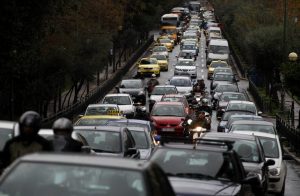Tensions heated up along Israel’s Lebanese border, as the Israeli military approved a plan for a possible invasion of its northern neighbor and Hezbollah showed off what it said was drone surveillance of northern Israeli cities.
The Israeli military plans outline an assault into Lebanon should a larger-scale conflict between Israel and Hezbollah break out. The operation would need approval from the Israeli government. Hezbollah’s video showed what it claimed were sensitive sites located miles inside Israeli territory and was perceived as a warning that the militant group has intelligence about where to strike Israel.
Israel and Hezbollah have exchanged tit-for-tat fire since Oct. 7 when the Iran-aligned militia backed attacks by Palestinian movement Hamas that sparked a war in Gaza. While both Hezbollah and Israel have been reluctant to turn hostilities into a bigger conflict, the two sides are increasingly signaling an intent to expand their fight.
The enemies have already exchanged fire deeper and more forcefully into their respective territories in recent weeks. Throughout Tuesday, Israeli warplanes launched strikes against squads from Hezbollah’s air force unit that were sending drones destined for Israel, the Israeli military said.
Hezbollah on Wednesday announced the deaths of three of its fighters and said it had fired dozens of rockets and shells at Israeli forces in response. Sirens sounded in Israel and the Israeli military said about 15 projectiles had entered its territory.
The Israeli military’s approval of operational plans for an offensive in Lebanon is “part of the efforts to send a message to Hezbollah to scale down their activities and show readiness to move forward to some sort of settlement,” said Yossi Kuperwasser , a former head of research for Israeli military intelligence.
Meanwhile, U.S. special envoy Amos Hochstein was in the Middle East this week seeking to head off a broader conflict that would complicate President Biden’s bid for re-election later this year. Hochstein visited Israel on Monday to meet with Israeli Prime Minister Benjamin Netanyahu , before traveling to Lebanon Tuesday to meet senior officials.
“The situation is serious,” Hochstein told reporters Tuesday in Lebanon. “We have seen an escalation over the last few weeks, and what President Biden wants to do is to avoid a further escalation to a greater war.”
The U.S. diplomatic push comes after an Israeli strike last week in southern Lebanon killed Taleb Sami Abdullah , one of the most senior members of Hezbollah. The militant group responded by firing hundreds of rockets and drones at Israel over three days.
Hezbollah says that its attacks are in support of the Palestinians and that it won’t stop until Israel ceases its war in Gaza . Both Hamas and Hezbollah are U.S.-designated terrorist organizations closely aligned with Iran. A fight against Hezbollah would be a far tougher task for Israel, which estimates the Lebanese group has amassed an arsenal of more than 150,000 rockets and missiles that military analysts say could overwhelm Israel’s antimissile defenses.
In a televised address in Beirut, Hezbollah leader Hassan Nasrallah warned Israel that “no place in the country is safe from our rockets.” Nasrallah was speaking at a memorial ceremony for Abdullah.
In all, the Lebanese militant group has launched more than 5,000 rockets, antitank missiles and explosive drones at Israel since the conflict started, according to the Israeli military. Hezbollah has lost at least 338 fighters, according to a tally based on the group’s statements. Some 95 Lebanese civilians have been killed, according to OCHA, the United Nations humanitarian agency, and Lebanese officials.
In Israel’s north, at least 17 soldiers and nine civilians have been killed because of the hostilities, according to Alma Research and Education Center, a nonprofit research center focusing on the threats on Israel’s northern border. The low-intensity conflict has left more than 60,000 Israelis displaced from their homes.
The casualties pale in comparison with the war in Gaza. More than 37,000 Palestinians have been killed there since the start of the war, most of them civilians, according to Palestinian health authorities. The figures don’t specify how many were combatants. Hamas’s attacks on Oct. 7 killed 1,200 people, mostly civilians, according to Israeli authorities.
Israel over the weekend initiated a humanitarian pause in fighting to help increase the flow of aid into the war-torn enclave. More than 1,000 truckloads of aid were piled up at the Gazan side of an Israeli border crossing a day later, as the United Nations said distribution inside the strip is being complicated by people looting the trucks.
U.S.-promoted talks for a cease-fire in Gaza have largely stalled after Israel and Hamas couldn’t agree on whether a truce would be permanent or would allow the Israeli military to later re-engage the militants in the Palestinian enclave.
Part of Hezbollah’s goal in increasing attacks on Israel in recent weeks was to force it to agree to a cease-fire that left Hamas intact in Gaza, Kuperwasser said. In that sense, the hostilities on Israel’s northern border were still a “controlled escalation,” he added.
Write to Rory Jones at Rory.Jones@wsj.com



